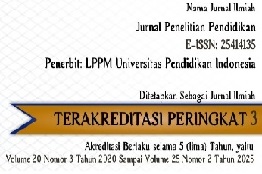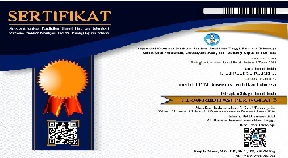The Implementation of School from Home in English for Young Learners' Classrooms
Abstract
The sudden occurrence of the coronavirus pandemic (COVID-19) has affected the education sector in Indonesia. The Indonesian government responded to this matter and issued a policy on the implementation of distance learning or known as the school from home. School from home has been applied to all education levels in Indonesia, including primary schools. This qualitative case study investigates the implementation of school from home in English for young learners' classrooms at a primary school in Indonesia. The data was collected through online classroom observation in second, fourth, and sixth-grade classrooms and interviews with five English teachers who taught in first until sixth-grade classrooms. Data from the interview were analyzed using thematic analysis, resulting in three generated themes on the implementation of school from home in English for young learners' classrooms. The themes include teachers' readiness to implement school from home, teachers' strategies to implement online learning as part of the school from home, and teachers' strategies to overcome challenges in online learning. The results of the study indicated that the implementation of school from home requires thorough preparation and has the potential to be implemented in English for young learners' classrooms, especially in the upper-grade classrooms of primary schools.
Keywords
Full Text:
PDFReferences
Anugrahana, A. (2020). Hambatan, Solusi dan Harapan: Pembelajaran Daring Selama Masa Pandemi Covid-19 Oleh Guru Sekolah Dasar. Scholaria: Jurnal Pendidikan dan Kebudayaan, 10(3), 282–289. https://doi.org/10.24246/j.js.2020.v10.i3.p28 2-289
Astuti, I. Y., & Harun, H. (2020). Tantangan Guru dan Orang Tua dalam Kegiatan Belajar Dari Rumah Anak Usia Dini pada Masa Pandemi Covid-19. Jurnal Obsesi : Jurnal Pendidikan Anak Usia Dini, 5(2), 1454–1463. https://doi.org/10.31004/obsesi.v5i2.808
Banu, S. N., Palukuri, V., Mutyala, S., & Kumar, K. V. (2021). English language teaching to young learners in the socially distanced classroom: A critical review. Linguistics and Culture Review, 5(S3), 1548-1557. https://doi.org/10.21744/lingcure.v5nS3.1827
Brew, L. S. (2008). The Role of Student Feedback in Evaluating and Revising a Blended Learning Course. Internet and Higher Education, 11, 98-105.
Brown, H. D. (2001). Teaching by Principles: An Interactive Approachto Language Pedagogy. WhitePlains, NY: Longman.
Brown, M. (2020). Education in the time of the virus, or, flying the plane while building it. Educause Review.
Volchenkova, K., Bryan, A., & Semenova, Y. (2018). Journey without maps: designing a teacher-training course for English-medium instruction. In EDULEARN18 Proceedings (pp. 2758-2766). IATED.
Chaw, L. Y., & Tang, C. M. (2018). What Makes Learning Management Systems Effective for Learning? Journal of Educational Technology Systems, 47(2), 152–169. https://doi.org/10.1177/0047239518795828
Clements, D. (1998). Young children and technology. (ERIC Document Re- production Service No. ED416991)
Clements, D. H., & Nastasi, B. K. (1993). Electronic media and early childhood education.In B.Spodek(Ed.), Handbok of research on the Education of young children (p.251- 275).NewYork:Macmilan.
Creswell, J. W., & Creswell, J. D. (2017). Research design: Qualitative, quantitative, and mixed methods approaches. Sage publications.
Damayanti, I. L. (2019). Cerita (Stories): A Pedagogical Model for Teaching Story Genres to Lower Secondary School Students in Indonesia. (Doctoral dissertation). University of Wollongong, Faculty of Social Sciences, School of Education, Wollongong, Australia
Damayanti, I. L., & Sibarani, B. L. (2021). WhatsApp with Preservice Teacher Learning Experiences in the Midst of COVID-19 Pandemic. Language, Education, and Policy for the Changing Society: Contemporary Theory and Research, March. https://www.researchgate.net/profile/Ika-Damayanti/publication/349683000_WHATSAPP_WITH_PRESERVICE_TEACHER_LEARNING_EXPERIENCES_IN_THE_MIDST_OF_COVID-19_PANDEMIC/links/604adaf145851543166f2bec
Dong, C., Cao, S., & Li, H. (2020). Young children' s online learning during COVID-19 pandemic : Chinese parents' beliefs and attitudes. Elsevier
Dumford, A.D.; Miller, A.L. Online learning in higher Education: Exploring advantages and disadvantages for engagement. J. Comput. High. Educ. 2018, 30, 452–465. [CrossRef]
Eysenck, M. W. (2014). Depth, elaboration, and distinctiveness. Levels of Processing in Human Memory (PLE: Memory), 5, 89.
Ganesha, P., & Nandiyanto, A. B. D. (2021). Application of Online Learning During the Covid-19 Pandemic through Zoom Meeting at Karya Mekar Elementary School. Indonesian Journal of Teaching in Science, 1(1), 1–8. https://ejournal.upi.edu/index.php/IJoTis/article/view/33534
Given, L. M. (2008). The sage encyclopedia of qualitative research methods. Thousand Oaks, CA: Sage.
Goodall, J., & Montgomery, C. (2014). Parental involvement to parental engagement: A continuum. Educational Review, 66(4), 399– 410.
Guan, C., Ding, D., & Ho, K. W. (2015). E-Learning in Higher Education for Adult Learners in Singapore. International Journal of Information and Education Technology, 5(5), 348–353. https://doi.org/10.7763/ijiet.2015.v5.528
Hannay, M., & Newvine, T. (2006). Perceptions of Distance Learning : a Comparison of Online and Traditional Learning. 2(1), 1–11.
Harmer, J. (2007). The practice of English language teaching. Pearson longman.
Hatip, A., 2020. The Transformation Of Learning During Covid-19 Pandemic Towards The New Normal Era. PROCEEDING UMSURABAYA.
Hatta, P., Aristyagama, Y. H., Yuana, R. A., & Yulisetiani, S. (2020). Active Learning Strategies in Synchronous Online Learning for Elementary School Students. IJIE (Indonesian Journal of Informatics Education), 4(2), 86. https://doi.org/10.20961/ijie.v4i2.46019
Hikmah, A., Wuryandani, W., Zubaidah, E., Herwin, H., & Jhon, W. (2021). Online Learning in Primary School during Covid-19 Pandemic: How Does It Look Like? Journal of Education Research and Evaluation, 5(3), 350–361. https://ejournal.undiksha.ac.id/index.php/JERE/article/view/34237
Hodges, C. B., Moore, S., Lockee, B. B., Trust, T., & Bond, M. A. (2020). The difference between emergency remote teaching and online learning.
Holt, D. T., Armenakis, A. A., Harris, S. G., & Feild, H. S. (2007). Toward a Comprehensive Definition of Readiness for Change: A Review of Research and Instrumentation. In W. A. Pasmore & R. W. Woodman (Eds.), Research in Organizational Change and Development (Vol. 16, pp. 289–336). Emerald Group Publishing Limited. https://doi.org/10.1016/S0897-3016(06)16009-7
Hrastinski, S. (2008). Asynchronous and synchronous e-learning. Educause quarterly, 31(4), 51–55. Retrieved from https://net.educause.edu/ir/library/pdf/eqm0848.pdf
Imani, C., Emaliana, I., & Sumyarto, S. (2021). SRL In Elementary School Students’ English Language Learning: A Case Study. IDEAS: Journal on English Language Teaching and Learning, Linguistics and Literature, 9(2), 310-318.
Wicks, M. (2010). A National Primer on K-12 Online Learning. Version 2. International association for K-12 online learning.
Khurshid, F. (2020). E-Pedagogical Skills of Online Instructors: An Exploratory Study. Bulletin of Education & Research, 42(2), 235–250.
Kim, K. J., Liu, S., & Bonk, C. J. (2005). Online MBA students' perceptions of online learning: Benefits, challenges, and suggestions. The Internet and Higher Education, 8(4), 335-344.
Kuama, S., & Intharaksa, U. (2016). Is online learning suitable for all English language students? PASAA: Journal of Language Teaching and Learning in Thailand, 52(December), 53–82. http://libproxy.usc.edu/login?url=https://search.proquest.com/docview/1895977430?accountid=14749
Lama, D. (2006). Using ICT to support young learners who are non-native speakers of English. IATEFL Young Learner Newsletter, 6, 26–27.
Lastrucci, E., Infante, D., & Pascale, A. (2009). From distance education to e-learning as integrated training. In Encyclopedia of information communication technology (pp. 160-165). IGI Global.
McBrien, J. L., Jones, P., & Cheng, R. (2009). Virtual spaces: Employing a synchronous online classroom to facilitate student engagement in online learning. International Review of Research in Open and Distance Learning, 10(3), 1–17. https://doi.org/10.19173/irrodl.v10i3.605
McKay, P. (2006) Assessing Young Language Learners. CUP, Cambridge.
https://doi.org/10.1017/CBO9780511733093
Misra, P. K. (2021). Covid-19 Pandemic in India : Lessons for Policymakers Online Teacher Professional Development Activities During the Covid-19 Pandemic in India : Lessons for Policymakers. April.
Mukarromah, U., & Wijayanti, W. (2021). Implementation of the online learning at vocational high school during Covid-19: Between obligations and barriers. Jurnal Pendidikan Vokasi, 11(1), 92–101. https://doi.org/10.21831/jpv.v11i1.37110
Ng, K. C. (2007). Replacing face-to-face tutorials by synchronous online technologies: Challenges and pedagogical implications. International Review of Research in Open and Distance Learning, 8(1), 1–15. https://doi.org/10.19173/irrodl.v8i1.335
Octaberlina, L. R., & Muslimin, A. I. (2020). Efl students perspective towards online learning barriers and alternatives using moodle/google classroom during covid-19 pandemic. International Journal of Higher Education, 9(6), 1–9. https://doi.org/10.5430/ijhe.v9n6p1
Palupi, I. R., & Raharjo, W. (2020). Zoom As A Tool For Online Learning. 1(1), 161–165. https://doi.org/10.31098/pss.v1i1.192
Panti, L. T. (2020). Experts see an even shorter attention span for children under online learning. Retrieved from https://www.gmanetwork.com/news/topstories/nation/740624/experts-see-even-shorter-attention-span-for-children-under-online-learning/story/
Perveen, A. (2016). Synchronous and Asynchronous E-Language Learning: A Case Study of Virtual University of Pakistan. Open Praxis, 8(1), 21. https://doi.org/10.5944/openpraxis.8.1.212
Piaget, J. (1955). The Language and Thought of the Child. New York: Meridian Books.
Pinter, A., & Zandian, S. (2014). "I don't ever want to leave this room": Benefits of researching "with" children. ELT Journal, 68(1), 64–74. https://doi.org/10.1093/elt/cct057
Riwayatiningsih, R., Setyarini, S., & Putra, R. A. A. (2021). Portraying Teacher's Metacognitive Knowledge to Promote EFL Young Learners' Critical Thinking in Indonesia. International Journal of Language Education, 5(1), 552-568.https://doi.org/10.26858/IJOLE.V5I1.13043
Ragin, G, Refando, A, & Utami, D. C. (2020). Implementasi Strategi Pembelajaran Ekspositori untuk Meningkatkan Hasil Belajar Matematika di Sekolah Dasar. PANDAWA, 5(1), 54–60.
Rasmitadila, Aliyyah, R. R., Rachmadtullah, R., Samsudin, A., Syaodih, E., Nurtanto, M., & Tambunan, A. R. S. (2020). The perceptions of primary school teachers of online learning during the covid-19 pandemic period: A case study in Indonesia. Journal of Ethnic and Cultural Studies, 7(2), 90–109. https://doi.org/10.29333/ejecs/388
Rice, K., & Dawley, L. (2009). The status of professional development for K-12 online teachers: Insights and implications. Journal of Technology and Teacher Education, 17(4), 523-545. Retrieved from http://edtech.boisestate.edu/goingvirtual/goingvirtual1. pdf.
Romano, M. E. (2008). Online discussion as a potential professional development tool for first-year teachers. Technology, Pedagogy and Education, 17(1), 53–65. https://doi.org/10.1080/14759390701847591
Santosa, D. S. S, Sampaleng, D, & Amtiran, A. (2020). Meningkatkan Prestasi Belajar Siswa Melalui Model Pembelajaran SIKIP. Jurnal Pendidikan Agama Kristen, 1(1), 11–24.
Schaefer, C. E., & Millman, H. L. (1981). How to Help Children with Common Problems. Ontario: Van Nostrand Reinhold Company.
Vai, M., & Sosulski, K. (2011). Essentials of online course design: A standards-based guide. Routledge.
Suputra, P. E. D., Nitiasih, P. K., Made, I., & Paramarta, S. (2020). Kelas Daring Bahasa Inggris di Masa Pandemi: Sebuah Tantangan Pembelajaran. Seminar Nasional Riset Inovatif, 7, 110–118. https://eproceeding.undiksha.ac.id/index.php/senari/article/view/2129
Susilowati, E. (2020). Bagaimana Pembelajaran Daring Di Tengah Wabah Covid 19 Melalui Grup WhatsApp?. Jurnal Pendidikan Matematika Raflesia, 5(3), 1-25.
Swauger, M., Castro, I. E., & Harger, B. (2017). The continued importance of research with children and youth: The “new” sociology of childhood 40 years later. In Researching children and youth: Methodological issues, strategies, and innovations. Emerald Publishing Limited.
Wang, Z., Pang, H., Zhou, J., Ma, Y., & Wang, Z. (2021). "What if…it never ends?": Examining challenges in primary teachers' experience during the wholly online teaching. Journal of Educational Research, 114(1), 89–103. https://doi.org/10.1080/00220671.2021.1884823
Widiastuti, Y. K. W., Rasmani, U. E. E., & Wahyuningsih, S. (2020). Mengkaji Penerapan E-Learning pada Anak Usia Dini. Jurnal Obsesi : Jurnal Pendidikan Anak Usia Dini, 5(2), 1240–1247. https://doi.org/10.31004/obsesi.v5i2.752
Williams, M., & Moser, T. (2019). The Art of Coding and Thematic Exploration in Qualitative Research. International Management Review, 15(1), 45–55.
Yelland, N. (2005). The Future is Now: A Review of the Literature on the Use of Computers in Early Childhood Education (1994-2004). AACE Journal, 13(3), 201–232.
Zhao, L., Thomas, P., & Zhang, L. (2021). Do our children learn enough in Sky Class? A case study: online learning in Chinese primary schools in the COVID era March to May 2020. Smart Learning Environments, 8(1). https://doi.org/10.1186/s40561-021-00180-9
Zheng, X., Zhang, D., Lau, E. N. S., Xu, Z., Zhang, Z., Mo, P. K. H., Yang, X., Mak, E. C. W., & Wong, S. Y. S. (2022). Primary School Students' Online Learning During Coronavirus Disease 2019: Factors Associated With Satisfaction, Perceived Effectiveness, and Preference. Frontiers in Psychology, 13(March), 1–11. https://doi.org/10.3389/fpsyg.2022.784826
Zweig, J. S., & Stafford, E. T. (2016). Training for online teachers to support student success: Themes from a survey administered to teachers in four online learning programs. Journal of Online Learning Research, 2, 399–418. www.learntechlib.org
DOI: https://doi.org/10.17509/jpp.v22i2.49062
Refbacks
- There are currently no refbacks.
Copyright (c) 2022 Jurnal Penelitian Pendidikan
ISSN: p.1412-565X e.2541-4135
Jurnal Penelitian Pendidikan (JPP), Universitas Pendidikan Indonesia 
This work is licensed under a Creative Commons Attribution-ShareAlike 4.0 International License
Statcounter


